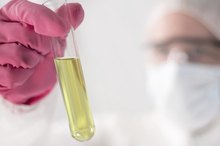What does fact checked mean?
At Healthfully, we strive to deliver objective content that is accurate and up-to-date. Our team periodically reviews articles in order to ensure content quality. The sources cited below consist of evidence from peer-reviewed journals, prominent medical organizations, academic associations, and government data.
- National Kidney and Urologic Diseases Information Clearinghouse: Kidney Stones in Adults
- Medline Plus: Urethritis
- Mayo Clinic: Kidney Infection (Pyelonephritis)
The information contained on this site is for informational purposes only, and should not be used as a substitute for the advice of a professional health care provider. Please check with the appropriate physician regarding health questions and concerns. Although we strive to deliver accurate and up-to-date information, no guarantee to that effect is made.
Common Excretory System Diseases
The main function of the excretory system, also referred to as the urinary system, is to maintain a proper balance of body fluids through the excretion of waste products. Other functions include salt balance in the body and blood and the production of important hormones. The excretory system consists of the kidneys, bladder, ureters and urethra. Common excretory diseases can affect any part of the system and cause serious complications if left untreated.
If you are experiencing serious medical symptoms, seek emergency treatment immediately.
Kidney Stones
Kidney stones are hard masses that form in the urinary tract from crystals that have separated from the urine. The most common type of kidney stone is formed from calcium, but other types include a struvite stone or uric acid stone, according to the National Kidney and Urologic Diseases Information Clearinghouse. The exact cause of kidney stones is unknown, but those with certain genetic disorders, kidney disorders and recurrent urinary tract infections are more likely to develop kidney stones. Symptoms of kidney stones include extreme pain, cramping in the back and lower abdomen, nausea and vomiting. Most kidney stones can be passed by increasing daily fluid intake to two to three quarts of water per day. If stones are too large to pass with an increase in water consumption, surgery may be needed to break the stones.
- Kidney stones are hard masses that form in the urinary tract from crystals that have separated from the urine.
- If stones are too large to pass with an increase in water consumption, surgery may be needed to break the stones.
Urethritis
What Are the Causes of Painful Ejaculation?
Learn More
Urethritis is an inflammation of the urethra caused by a bacterial or viral infection 1. The infection can be caused by the same microbes that cause urinary tract infections, gonorrhea, chlamydia and herpes simplex. Symptoms of urethritis vary between the sexes 1. Symptoms in women include:
- abdominal pain
- pain during urination
- fever
- chills
- frequent urination
- pain in the pelvis
- vaginal discharge
- according to Medline Plus 1
Treatment for urethritis includes antibiotics or anti-viral medication 1. Pain medications may also be prescribed to reduce symptoms associated with urethritis 1. During treatment, sexual intercourse should be avoided.
Pyelonephritis
Pyelonephritis is a type of urinary tract infection that travels to the kidneys from the urethra or bladder 2. The infection occurs when bacteria enter the body through the urinary tract. Symptoms of pyelonephritis include:
- fever
- pain in the groin
- abdominal pain
- frequent urination
- persistent urge to urinate
- burning during urination
- blood in the urine
- according to MayoClinic.com
Treatment for pyelonephritis usually consists of oral antibiotics. If the infection is severe, antibiotics may be need to be administered intravenously during a hospital stay. If left untreated, pyelonephritis can lead to permanent kidney damage or infections of the blood 2.
- Pyelonephritis is a type of urinary tract infection that travels to the kidneys from the urethra or bladder 2.
- If left untreated, pyelonephritis can lead to permanent kidney damage or infections of the blood 2.
Related Articles
References
- Medline Plus: Urethritis
- Mayo Clinic: Kidney Infection (Pyelonephritis)
- Young A, Wray AA. (2019) Urethritis. Treasure Island, Florida: StatPearls Publishing [Internet].
- Ward H, Rönn M. Contribution of sexually transmitted infections to the sexual transmission of HIV. Curr Opin HIV AIDS. 2010;5(4):305-10. doi:10.1097/COH.0b013e32833a8844
- Moi H, Blee K, Horner PJ. Management of non-gonococcal urethritis. BMC Infect Dis. 2015;15:294. doi:10.1186/s12879-015-1043-4
- Bachmann LH, Johnson RE, Cheng H, et al. Nucleic acid amplification tests for diagnosis of Neisseria gonorrhoeae oropharyngeal infections. J Clin Microbiol. 2009;47(4):902-7. doi:10.1128/JCM.01581-08
- Brill JR. Diagnosis and Treatment of Urethritis in Men. Am Fam Physician. 2010 Apr;81(7):873-8.
- Centers for Disease Control and Prevention. Sexually Transmitted Diseases Treatment Guidelines, 2015. Atlanta, Georgia; updated June 5, 2015.
- Bachmann L, Manhart LE, Martin DH, et al. Advances in the understanding and treatment of male urethritis. Clin Infect Dis. 2015 Dec 15;61 (Suppl 8):S763-9. doi:10.1093/cid/civ755
Writer Bio
Lindsay Boyers has a Bachelor of Science in nutrition from Framingham State College and a certificate in holistic nutrition from the American College of Healthcare Sciences. She is also a licensed aesthetician with advanced training in skincare and makeup. She plans to continue on with her education, complete a master's degree program in nutrition and, ultimately, become a registered dietitian.








